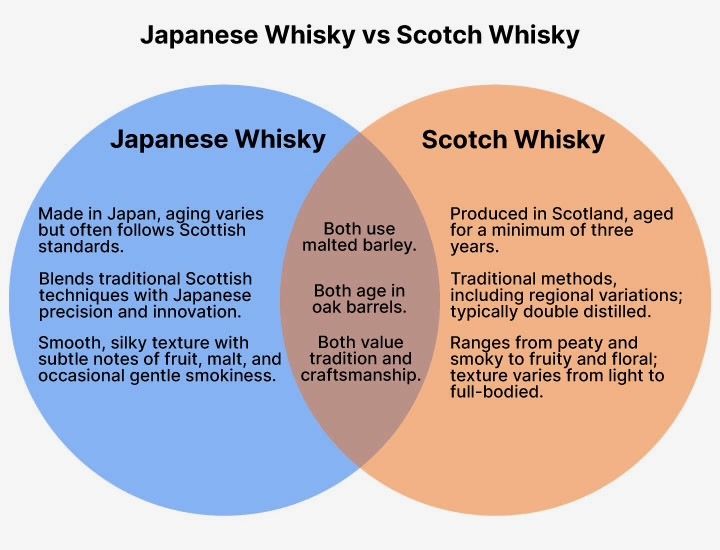In the world of Japanese whisky, efficiency doesn’t come at the sacrifice of quality. Owner Derek Burnell, who serves Japanese whisky at his restaurant, COBRA, remembers hearing a story that a distiller at Yamazaki ate the same exact meal every day for thirty years straight, at the exact same time, so that his palate never changed, and thus his discerning taste bids would never go off kilter. Though this may be apocryphal, it shows why so many have fallen in love with this spirit with its rich history and unique flavor profile.
Japanese Whisky’s History is as Rich as its Flavor
Whisky or whiskey (with the “e” for American-made or Irish-made spirits), has existed since at least the 13th century, but Japanese whisky is relatively new. The official definition of whisky says that it is any type of liquor made from fermenting grain mash, and classified by how many times the grain is “malted’ (how long the grains soak in water), how it’s fermented, and then how it’s distilled.
The aging process of whisky and its relative scarcity are what makes whiskies like Suntory Yamazaki so expensive. (Beyoncé and Jay-Z are among many high-profile, big budget Yamazaki fans). But Japanese whisky isn’t just a luxury export—its history comes from hardworking distillers who found their passion in bringing a new liquor to the Japanese market.
Scotch, Whisky, and Bourbon
To refresh, whisky is a spirit made from distilling and fermenting grains, such as corn, rye, barley, or wheat. Two of whisky’s most prominent stylistic categories, which provide a point of context or Japanese whisky, are Scotch and bourbon. Bourbon and Scotch are both whiskies, but not all whiskies are Scotches or Bourbons. Scotch comes from Scotland and focuses on the smoky flavors of peat. Bourbon comes exclusively from America, and is predominantly corn, aged in new, charred oak barrels, which results in a sweeter flavor, with more tendency towards vanilla or caramel in its profile.
Japanese whisky is much closer to Scotch in its flavor profile, since distillers first encountered whisky in Scotland. For a whisky to be considered Japanese whisky, it has be fermented, distilled, aged and bottled in Japan, use some part of malted grain in its mash, and use water sourced from Japan, after stricter labeling laws went into effect in 2024. The chart below illustrates the similarities and differences between Scotch and Japanese whisky.

How Did Whisky Get to Japan?
The story of Japanese whisky is full of larger-than-life characters. Shinjiro Torii, the founder of Suntory, the most famous Japanese distillery “house,” was originally a wine importer. Japan was coming off of the Meiji period, when after years of sakoku (closed borders), the country opened again to foreign trade and influences. The Tokugawa shogunate collapsed in 1867, and Japan rapidly industrialized from there under the rule of Emperor Meiji.
Torii opened a small imports store in 1887, but nobody took much interest in the wines he was selling. He decided he wanted to develop more spirits for the Japanese palate. His first project was Akadama, a fortified wine designed to pair with Japanese food—you can still buy it today. Akadama was better received than his imported wines, but next Torii took on the challenge of fighting the belief that good whisky could only come from Scotland. He earned the nickname “the nose of Osaka” for his uncanny ability to taste and smell complex flavor profiles in his blending process.
In the early twentieth century, a chemistry student at University of Glasgow found himself enamored with scotch, as Torii was years before. Masataka Taketsuru came from a family of sake distillers, but he wanted something more out of his spirits. He fell in love with a Scottish woman—despite disapproval from both of their families, and the pair moved back to Japan. After completing an apprenticeship with Suntory, Taketsuru started his own distillery: Nikka, in the mountains of Hokkaido.
Japanese Whisky in the American Market
If you’re looking for an entry point to Japanese whisky, Burnell noted that in the States, Suntory Toki is one of the most accessible ones, that won’t set you back nearly as much as something like Yamazaki 55, which retailed at an auction for almost $60,000.
But if you’re not ready to drink Japanese whisky neat, the best cocktail for you is the Highball. While it may have originated in England, the Highball gained its zenith of popularity in Japan as a whisky and soda. Most craft cocktails bars in the States offer a younger Suntory Toki to make highballs, so you can try it out next time you’re looking to change up your typical order.
Japan is a complex country, one that westerners often exoticize or fetishize as either samurai and shogunates or salarymen and shinkansen trains. Japanese whisky has a commitment to quality, but its story is also that of cross-cultural exchange and the search for liquor that doesn’t just pair with European foods. Too often, European food pairings and flavor profiles are the standard for liquor. Trying Japanese whisky is an opportunity to expand your palate and a chance to experience liquor not just as an intoxicant but as a craft and an integral part of world history.
For more, check out the rest of our liquor education series:
- All About Gin
- Vodka Isn’t Just for Shots and Soda
- The Best Bottles of Tequila Blanco
- The Digestivo Digest
- Vermouth is the Apériitif You Need Right Now
Wondering what to cook to go with your drink? Try our food education series:
- Everything You Ever Wanted to Know About Olive Oil
- Knowing Spices Can Completely Change Your Kitchen Game
- How to Use Salt Correctly in Cooking
Story by Emma Riva
Photo by Yuri Shirota
Subscribe to TABLE Magazine’s print edition.

